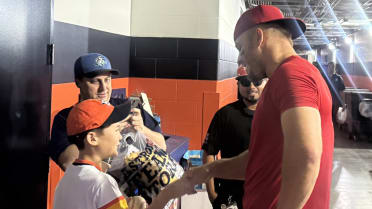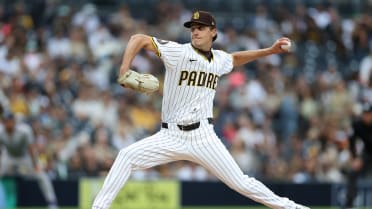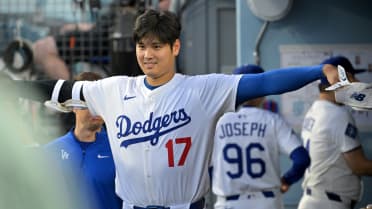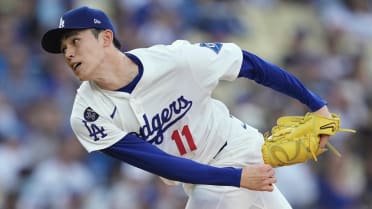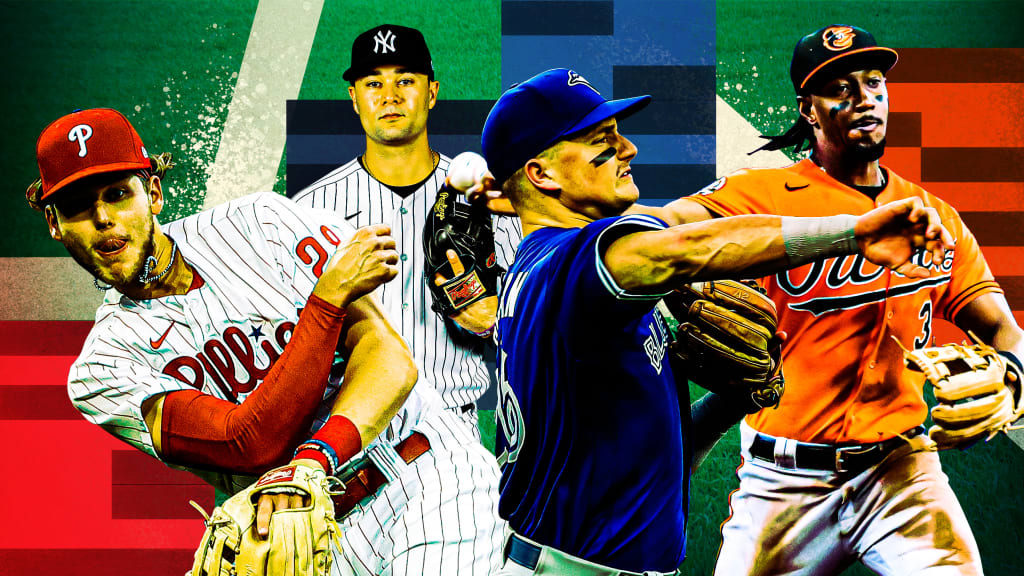
For as much emphasis as we put on strikeouts in today’s game -- and for good reason, because the seven best strikeout rate pitching staffs would all be playoff teams right now -- the truth is that approximately two-thirds of all plate appearances end with a ball in play. More often than not, someone’s got to try to catch the ball. One of the big reasons the Giants have taken a step back, for example, is that their defense has been massively worse.
But it works the other way, too. A few teams have improved their defense, either from 2021 or from even earlier this season. We’ve picked four clubs, all in playoff contention, where simply catching the ball has been a big part of this year’s success -- and how they’ve done it. (Every time you see “OAA” here, that’s Outs Above Average, the Statcast defensive metric.)
We are all but obligated to start with ...
The Phillies' infield
The big number: minus-20 OAA in May // plus-5 OAA in July
... because Philadelphia’s defense was always going to be a problem. How could it not be? They took a unit that was already below-average (24th in 2021, at minus-20 OAA), then added Kyle Schwarber and Nick Castellanos, two sluggers far better known for their bats than their gloves. It was an endless topic of conversation during the spring; at one point in March, The Athletic’s Jayson Stark noted that it was borderline unprecedented for a team as defensively challenged as this to make any October noise.
It was predictably poor in April, and downright abysmal in May, in part because Bryce Harper’s elbow injury limited him to DH, forcing Schwarber and Castellanos to play the field every day, and in part because Alec Bohm looked like he wouldn’t last the season at third base. The minus-20 OAA they piled up was the third-worst month for any team going back to 2016, and it sure looked the part.
Then they dismissed Joe Girardi in the first days of June, and the team started to win, and the defense ... got better. After being worst-in-baseball in May, it was 18th in June, and tied for 7th in July. It wasn’t just better; it was good, despite losing Jean Segura, the Phillies' best defensive infielder, after he broke a finger trying to bunt on May 31. Most surprisingly, it wasn’t new players, for the most part. It was the same group. How? Let’s present three reasons.
1) Alec Bohm got better.
You might remember Bohm from his infamous three-error disaster in early April that led to him uttering “I [expletive] hate this place,” or a pair of defensive mistakes on May 4, or any number of early-season fielding problems that put his future into question. With a minus-8 OAA, he was baseball’s weakest defender in May, but he’s been slightly above average (plus-2 OAA) since. The face of the team’s defensive ineptitude has now become, if not a strength, at least not a weakness.
Why? We’d argue confidence for a young player matters; note that he also had a mere .611 OPS in May and was Philadelphia’s best hitter in July (1.088 OPS), and it's hard not to notice the correlation there. But even if that's the primary reason here, we'd also point to something else, which is ...
2) The defensive positioning changed markedly.
... it might be the same players, but they're not in the same spots.
Last year, the shift-averse Braves started shifting midseason, and that change helped them ride to a title. This year’s Phillies attempted to do the same, because after last year’s club shifted 30th most of 30 teams, this year’s version was shifting twice as much early on; their 40% shift rate in June was their highest on record. They cut way back in July, down to 20%, third lowest. It doesn’t inherently mean shifting is good or bad, just that it wasn’t working for this particular group of players.
For example, take Bohm. Let's look at all the plate appearances where he was positioned at least 160 feet from the plate, which, for a third baseman, almost always means "is playing short right field in the shift."
2020 // 0 times
2021 // 0 times
2022, April through June 9 // 138 times
2022, June 10 through present // 1 time (Aug. 2)
Where it had previously been the shortstop alone on the left side, now it's largely Bohm. It's not necessarily the reason he's playing better, but it's a pretty notable change -- especially coming just a week after the team changed managers.
3) The pitching stopped making things so hard.
While the Phillies’ pitching has generally been solid this year -- only the Dodgers have allowed a lower hard-hit rate thus far -- they didn’t have a good May, either. In four of the five months in 2022, they’ve allowed a hard-hit rate between 32% and 34%. But in May, it was 40%. It was the third-worst hard-hit month they’ve allowed in eight seasons of Statcast tracking. When your defense is weak, the best strategy might just be “don’t allow blasted rockets at those weak gloves.”
It should be noted, there’s reason to think this will stick, or even improve. Last week, they cut ties with Didi Gregorius, who for years has rated as one of baseball’s weakest defensive shortstops (minus-76 since 2016). At the Deadline, they traded for Brandon Marsh, one of the best defensive outfielders in the game (plus-9 OAA this year), and Edmundo Sosa, a quality defensive infielder. It's not likely to be a great defense, no matter what. But it might, now, be one you can win with.
The Blue Jays' infield
The big number: minus-2 OAA in 2021 // plus-18 OAA in 2022
No one in Toronto was satisfied with their infield defense last season, so they went out and found the best defensive third baseman this side of Nolan Arenado in Matt Chapman, and now their infield defense has gone from below average to second best. Great job, great work. Add a great player, see your team improve. Well done.
Except ... except the metrics do not look upon Chapman favorably this year, dropping him all the way from plus-20 OAA last year to just 0, or average, this year. (For comparison’s sake, Defensive Runs Saved, a similar but unrelated metric, also has him at 0.)
We’ll get back to why in a second, but first, let’s note that even without the expected Chapman boost, the numbers still love this infield, and that’s because of the improvement of the young players who remained.
Some of this is easy to explain. Santiago Espinal was a good defender last year, and due to his improved bat he’s already played nearly 200 more innings in the field than he did all of last year. Cavan Biggio was forced into third base and right field positions he was ill equipped for last year, and this year he’s played almost exclusively the right side of the infield, where he fits best. Vladimir Guerrero Jr. is still just in his second full season at first, and he’s got a case to win a Gold Glove this year. We know the team is using positioning and shifting much differently, too, and there's an argument that Chapman's presence is indirectly aiding Bichette next to him.
But then there’s Chapman, where the reputation and eye test each surpass the uninspiring metrics. If you choose not to believe the numbers, that’s fine, though we’d note they accurately -- as far as most fans are concerned -- graded him out as excellent each year before. When we watched a lot of plays not made, we noticed they looked often like this ...
… and this …
… and that there are more than a few other plays that weren’t “errors,” but were transfer/throw plays you’d expect a player of Chapman’s reputation to make. You can actually see this in action if you split the OAA into “getting to the ball,” or how well his range and receiving are, and “completing the play,” or how well he’s getting the ball out and on to the base in question.
The range seems fine. For whatever reason, the act of getting the ball out of his hand and over to first base hasn't quite been. That doesn't mean it can't be, or won't be. Just that if you want to understand why the metrics are down on him, it might be that. And even despite all that, the numbers still all think this infield is tremendous.
The left side of the Yankees' infield
The big number: minus-15 OAA in 2021 // plus-14 OAA in 2022
This one’s a little easier, at least: Unlike our first two teams, the Yankees just went out and got different players, ones who are better defenders. We knew the club found its previous situation untenable when it shifted everyone around two weeks before the end of last season, largely to get Gleyber Torres off shortstop, where he was a minus-10 last year, and back to second base, where he’s a better-if-not-spectacular minus-1 this year.
Via trade with Minnesota, the Yankees markedly improved third base, thanks to shipping out Gio Urshela (minus-5 OAA), and imported Josh Donaldson (plus-7 OAA) while opening up more time for DJ LeMahieu (plus-4 at third), a big win. (While Urshela’s eye test usually outperforms his metrics, note that the Yankees kept talking about wanting to improve their defense … yet were happy to trade him out of town.)
In the same trade, they got Isiah Kiner-Falefa, who has been simultaneously mildly disappointing (minus-2) but a massive upgrade at shortstop over Torres. Just on the left side alone, the Yankees went from sixth weakest to third best -- and that doesn’t even include how they went from 23rd to best in catcher framing, thanks to the upgrade from Gary Sánchez to Jose Trevino.
Like with the Phillies, there’s potential for even more here. Center fielder Harrison Bader, acquired from St. Louis at the Deadline, hasn’t played yet as he recovers from a foot injury. When he’s available, he’s something special; since 2018, no outfielder has rated better by Statcast metrics.
The Orioles' infield
The big number: minus-27 OAA in 2021 // plus-4 OAA in 2022
Finally, we get to Baltimore, in the midst of one of baseball’s more stunning turnarounds, largely due to the O's incredibly good bullpen. While the outfield defense hasn't changed much, the infield defense has improved from 28th to 13th. Prefer an old-school number? Last year, they allowed a .262 average on grounders, which was second worst; this year, it’s .225, which is seventh best.
Either way, they’ve certainly come a long way from 2018, when articles were being written entitled “This Orioles Defense May Be the Worst We’ve Ever Seen,” and it starts, mainly, with shortstop Jorge Mateo, a long-ago Yankees prospect who was plucked off waivers from San Diego last August.
Primarily a utility player with the Padres, Mateo was Baltimore’s Opening Day shortstop, and he’s been there nearly every day since. While the bat has been just OK (87 OPS+), he’s flashed some of baseball’s most elite speed (to go with an AL-best 26 steals) -- and his plus-8 OAA is tied for sixth best among Major League shortstops. You can consider that more than a minor upgrade over the likes of Richie Martin, Jonathan Villar, Pat Valaika, Ramón Urías, Tim Beckham and most of the other shortstops of the previous four years -- a span over which O’s shortstops were baseball’s third worst.
But it’s more than just Mateo, isn’t it? Urías was overmatched at shortstop (minus-10 OAA in parts of three seasons); he’s been quite good at third base this year (plus-4 OAA). Ryan Mountcastle spent his first two seasons moving between first base and the outfield, where he didn't impress; exclusively a first baseman this year, he’s rated well, at plus-4 OAA. (“Feels like the first spring I've had where it's one position that I’m going to try to lock down,” he said in March. “And yeah, it feels good.”)
There’s still room for improvement, particularly at second base and in the outfield, though Adley Rutschman has added quite a bit of value behind the plate in his brief time up. Then again, that’s the Orioles in a nutshell, isn’t it? They’re much, much better. There’s still room for improvement. It’s happening there on defense. It’s happening all over.
Mike Petriello is a stats analyst for MLB.com, focusing on Statcast and Baseball Savant, and is also a contributor to MLB Network.

